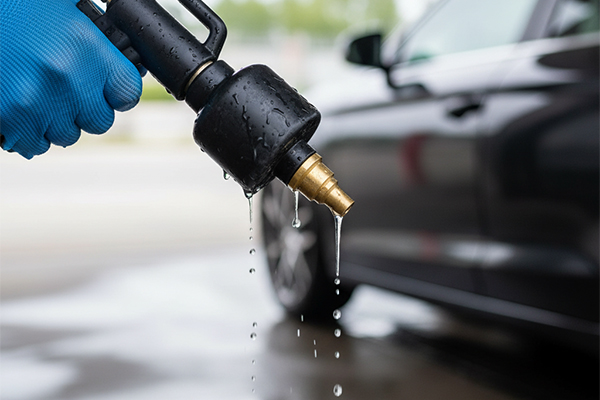Is 1.1 or 1.25 better for foam cannon?
Confused by foam cannon1 orifice sizes2? Choosing the wrong one can ruin your foam quality or even damage your pressure washer3. Let’s make sure you pick the right one.
For most home pressure washers, the 1.1mm orifice4 is better because it creates the right amount of pressure for thick, rich foam. The 1.25mm orifice5 is necessary for powerful, high-flow pressure washers (over 2.0 GPM6) to prevent damaging the pump.
In my 15 years of making cleaning products, I’ve seen how one tiny, inexpensive part can make or break the performance of a tool. The orifice inside your foam cannon is a perfect example. We manufacture and ship our foam cannons with both 1.1mm and 1.25mm options because there isn't one "best" size—there's only the "right" size for your specific machine. Picking the wrong one is a common mistake that leads to frustration. People either get watery foam and are disappointed, or worse, they put unnecessary strain on their equipment without realizing it. Let's clear this up so you can get the best result safely.
How does orifice size affect your pressure washer?
You might think the orifice only changes the foam. But picking one that's too small for a powerful machine can cause serious strain on its motor and pump, leading to costly damage.
A smaller orifice (1.1mm) increases pressure inside the cannon, which is great for low-power machines. But on a high-power washer, this restriction chokes the water flow7, causing dangerous back-pressure8 that can burn out the motor.

The most important thing to understand is that the orifice size has to match your pressure washer's power, specifically its flow rate, measured in Gallons Per Minute (GPM6). Think of it like putting your thumb over the end of a garden hose. With normal water flow7, this creates a nice, strong spray. But imagine trying to do that with a firefighter's hose. The pressure would be too immense and unsafe. A small 1.1mm orifice4 on a powerful, high-GPM pressure washer (like a 5000 PSI commercial unit) creates a similar bottleneck. The pump is trying to force a large volume of water through a tiny hole. This restriction causes pressure to build up behind the orifice, putting a heavy load on the pump and motor, which can cause them to overheat and fail. A 1.25mm orifice5 provides a larger opening, allowing the water to flow more freely. This relieves the strain and lets the machine run smoothly as it was designed to.
Orifice Size and Machine Compatibility
| Orifice Size | Best For Pressure Washers | Effect on Machine |
|---|---|---|
| 1.1mm | Standard / Home Use (Under 2.0 GPM) | Creates necessary back-pressure for thick foam9 without straining the smaller pump. |
| 1.25mm | High-Power / Commercial (Over 2.0 GPM) | Prevents dangerous back-pressure, allowing high water volume to pass through safely. |
Does a larger orifice always mean better foam?
Many people assume a bigger hole means more foam. But if you use a 1.25mm orifice on a standard home pressure washer, you will likely get thin, watery foam that just runs off your car.
No, a larger orifice does not guarantee better foam. Foam quality depends on the right balance of water, soap, and air. The 1.25mm orifice can produce watery foam on low-power machines because it fails to create enough pressure for proper mixing.

Creating thick, shaving-cream-like foam is a science. The foam cannon works by forcing water at high pressure through the orifice. This high-speed jet then pulls soap from the bottle and air from the atmosphere into the chamber, mixing them violently in a mesh filter to create suds. A standard home pressure washer has a relatively low flow rate (GPM). Using the smaller 1.1mm orifice creates a bottleneck that accelerates that water, generating the high pressure needed to properly mix the soap and air. This results in the thick foam9 you want. If you switch to the 1.25mm orifice with that same machine, the hole is too big. The water flows through too easily and doesn't accelerate enough. This lower pressure isn't strong enough to properly siphon and mix the soap and air, resulting in a weak, wet, and runny foam that provides poor cleaning performance10. So, for most users at home, bigger is definitely not better.
What are the downsides of each orifice size?
You now know which size is for which machine. But are there any other trade-offs or small annoyances you should be aware of before making your final choice for your product?
The main downside of the 1.1mm orifice is its danger if paired with a powerful washer. The downside of the 1.25mm orifice is a minor but noticeable dribble of water after you release the trigger, even when rinsing.

We've covered the major issue with the 1.1mm orifice: it's unsafe on high-GPM6 machines. As long as you use it with a standard consumer-grade washer, it is perfect. The 1.25mm orifice, however, has a small design quirk that comes from its larger size. Because the opening is bigger, it allows a greater volume of water to flow through the cannon's internal channels. When you are done foaming and use the cannon body just to rinse the car with clear water, this larger flow can be an issue. After you release the trigger and shut off the water, some of that excess water remains trapped in the passageways. For a few seconds after shutoff, this trapped water will continue to leak or dribble out from the nozzle tip. It's not a major defect, but it is a direct result of the physics of a wider orifice. It doesn't affect performance, but it's an important detail to know if you prioritize a perfectly clean shutoff.
Conclusion
Choose the 1.1mm orifice for standard home pressure washers to get the best foam. Use the 1.25mm orifice only for powerful, high-GPM machines to ensure safety and proper function.
Explore this resource to understand the mechanics of foam cannons and how they enhance car washing. ↩
Learn about various orifice sizes and their impact on foam quality and pressure washer performance. ↩
Gain insights into the functioning of pressure washers and how they relate to foam cannon performance. ↩
Discover why the 1.1mm orifice is ideal for home pressure washers and how it affects foam quality. ↩
Find out the specific scenarios where a 1.25mm orifice is necessary for high-power pressure washers. ↩
Explore the significance of Gallons Per Minute (GPM) in determining the compatibility of foam cannons. ↩
Learn how water flow dynamics influence the effectiveness of foam cannons in car washing. ↩
Understand the concept of back-pressure and its implications for pressure washer safety and performance. ↩
Learn tips and techniques for creating thick foam that enhances your car washing experience. ↩
Discover the relationship between foam quality and effective cleaning during car washes. ↩
